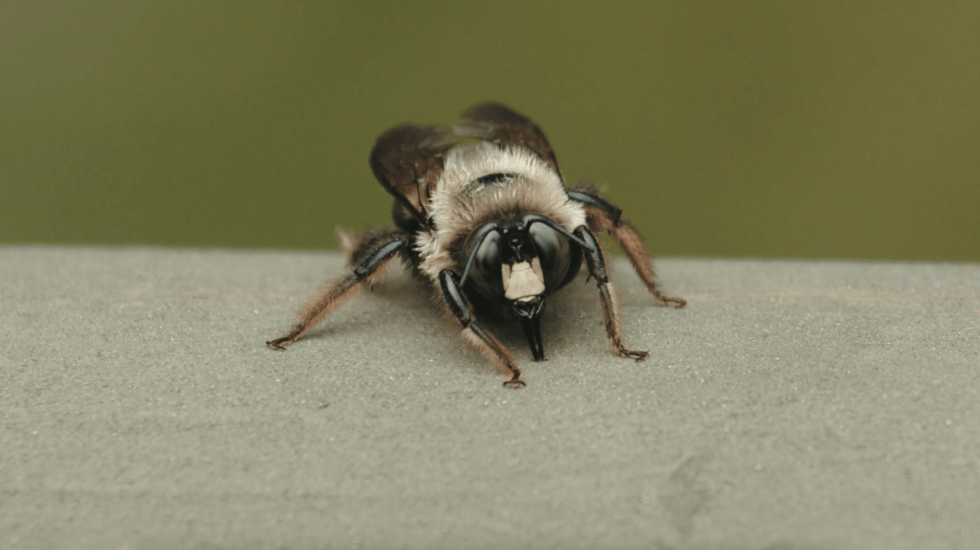Home | Knowledge Center | 2024 | Getting Rid of Carpenter Bees

Carpenter bees, often mistaken for bumblebees due to their size and coloration, are a unique species that can pose significant challenges for homeowners.
While they play an important role in pollination, their nesting habits can cause considerable damage to wooden structures. In this comprehensive blog post, we’ll delve into the world of carpenter bees, their impact on properties, and effective pest control solutions to help you get rid of carpenter bees. This guide will provide you with all the necessary information to understand and manage these industrious insects.
Understanding Carpenter Bees
Carpenter bees belong to the genus Xylocopa and are found in various regions across the United States. Unlike bumblebees and honey bees, which live in colonies, carpenter bees are solitary creatures. The most noticeable characteristic of these bees is their habit of boring into wood to create nests, which can be detrimental to the structural integrity of buildings and other wooden structures.
Physical Appearance
Carpenter bees are large, robust bees with a shiny, black abdomen, unlike the hairy abdomens of bumblebees. Males are typically more aggressive, though they lack a stinger, while females can sting but are generally non-aggressive unless provoked.
Behavior and Life Cycle
Carpenter bees emerge in spring, and like many insects, their life cycle revolves around nesting and reproduction. Females excavate tunnels in wood to lay their eggs, creating galleries where larvae will develop. These tunnels can extend several inches into the wood, causing structural damage over time.
The Impact of Carpenter Bees on Your Property
Carpenter bees’ nesting habits can have several implications for homeowners:
Structural Damage
The primary concern with carpenter bees is the damage they cause to wooden structures. Decks, eaves, siding, and wooden furniture can all fall victim to their tunneling activities. Over time, repeated infestations can lead to significant weakening of these structures, necessitating costly repairs.
Aesthetic Damage
The presence of carpenter bee holes can mar the appearance of wooden structures. Additionally, the yellowish stains from bee excrement often found near nesting sites can further degrade the aesthetic appeal of a property.
Secondary Infestations
The tunnels created by carpenter bees can attract other pests, such as wasps and hornets who can use the holes as starting points for their nests. In studies by the Cornell Lab of Ornithology, they found that carpenter bee larvae in the tunnels attract woodpeckers who come to feed on the larvae—exacerbating the damage to property. Because of these secondary pests, carpenter bee damage can be a catalyst for serious property damage.
Preventing Carpenter Bee Infestations
Effective prevention is key to protecting your property from carpenter bee damage. Here are some strategies to consider:
Paint and Varnish
Carpenter bees are less likely to bore into painted or varnished wood. Regularly applying a coat of paint or varnish to exposed wooden surfaces can deter them from boring their tunnels and nesting.
Wood Alternatives
Consider using non-wood materials, such as composite or vinyl, for structures like decks and siding. These materials are less appealing to carpenter bees.
Seal Cracks and Holes
Regularly inspect your property for any existing holes or cracks in the wood. Seal these with caulk or wood putty to prevent bees from using them as entry points
Screening
Install screens on vents and other openings to prevent bees from accessing these areas.
What to Do If You Have Carpenter Bees
If you already have a carpenter bee infestation, it’s crucial to address it promptly to minimize damage:
Identify the Infestation
Before getting rid of carpenter bees, you’ll need to look for perfectly round holes in wood surfaces, along with sawdust and yellowish stains, which are indicators of carpenter bee activity.
Apply Insecticides
There are various insecticides available that can be applied directly into the bee holes. It’s best to do this at night when the bees are less active. Always follow safety guidelines when using chemical treatments to kill carpenter bees.
Use Residual Sprays
Apply residual sprays around wooden structures to deter bees from boring into them. These sprays can provide long-lasting protection against future infestations and kill carpenter bee larvae before it hatches.
Plug the Holes
After treating the infestation, seal the holes with wood putty or caulk to prevent new bees from using the tunnels. This also helps stop other pests from entering.
Professional Pest Control Services
For severe infestations or if you’re unsure how to handle the problem, it’s wise to contact a professional pest control service like Advanced Pest Control.
Conclusion
Carpenter bees, while beneficial pollinators, can cause significant damage to wooden structures on your property. Understanding their behavior and impact is crucial for effective prevention and management. On the positive side of pest management, since carpenter bees are not social insects that live in hives, like honey or bumble bees— using pest control to protect your property won’t have the same impact on their populations as it would if they were a social insect.
If you find this interesting; share the article

Pest Management Expert
Stand away from the traffic?
Subscribe to our Newsletter today
Unfortunately You cannot copy contents for intellectual properties reasons :(